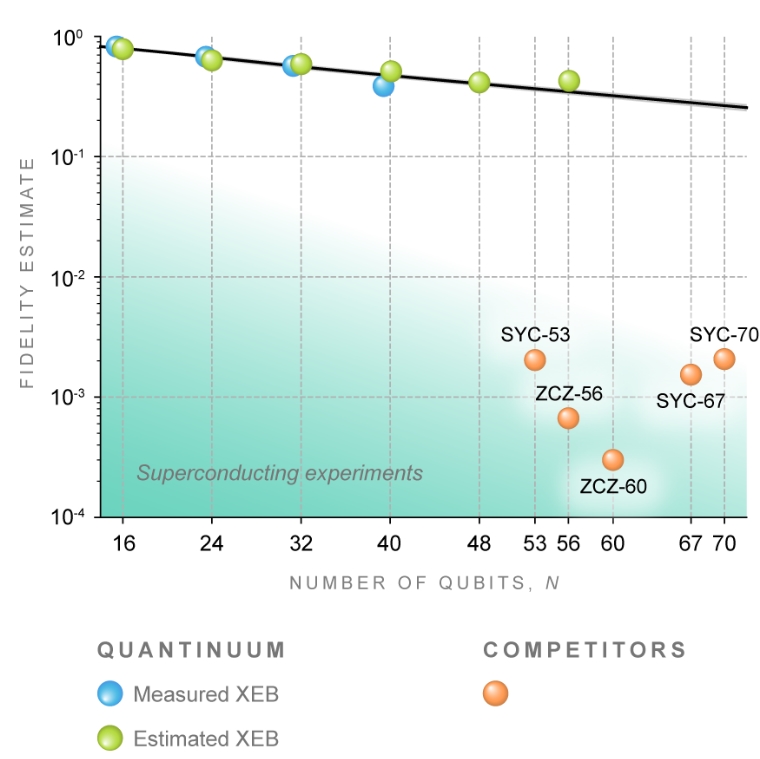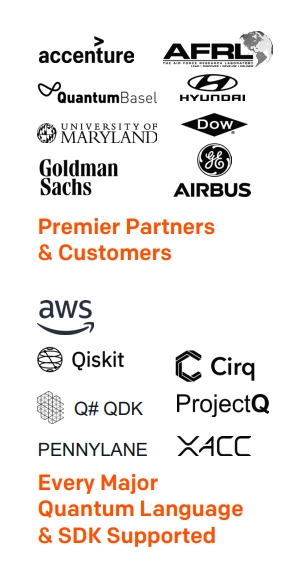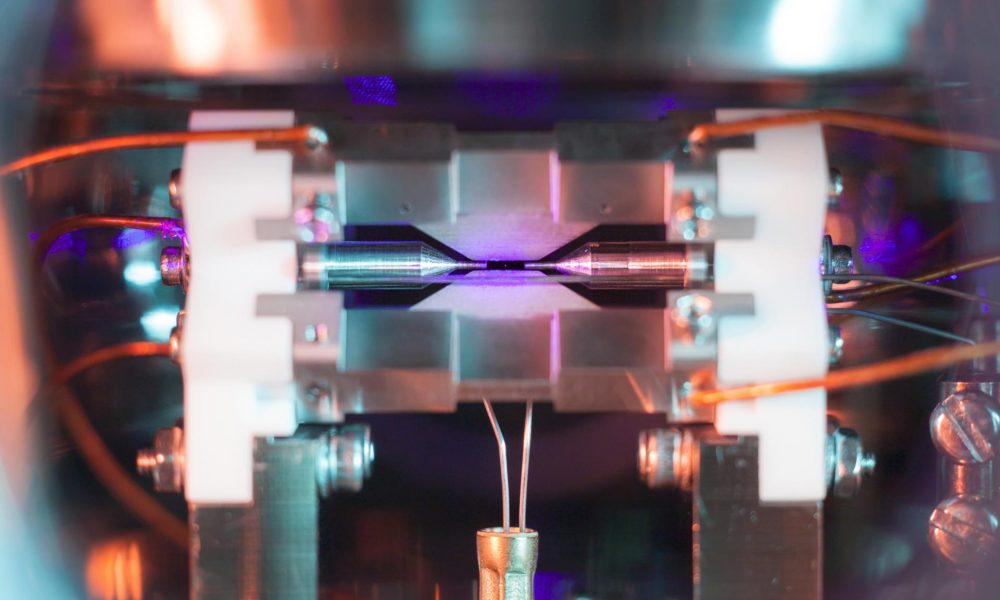Scaling Up Quantum Computing
Quantum computers are expected to one day become the core technology for advanced computation within biotechnology, material sciences, finances, cryptography, and other complex systems that silicon-based computers struggle to deal with.
However, two things have been holding back quantum computers from becoming more commonplace.
The first thing is that the more qubits (the quantum equivalent to a binary bit) in a system, the higher the error, with any instability causing a domino effect.
This might soon be a problem of the past, thanks to recent progress made by Google (GOOGL +0.07%) and its Willow chip, which achieves a decreasing rate of error the more qubits are added.
The other issue is that there is likely a size limit to how big an individual quantum computer can get, in the same way, that a silicon chip can only become so powerful before running into problems with power supply, overheating, etc.
This too might be getting solved, thanks to the works of researchers at the University Of Oxford. They managed to create a distributed quantum computer network, similar to how servers using silicon-based chips work, potentially paving the way for quantum supercomputers.
They announced their results in the prestigious publication Nature, under the title “Distributed quantum computing across an optical network link”1.
Connecting Quantum Computers
The way quantum computers currently work is as isolated units, containing a few hundred or maybe a thousand qubits for the most advanced ones.
The issue is that growing them bigger is incredibly complex, as the bigger the system, the more instability and perturbations from the environment can disrupt the quantum effects the computer relies on.
At the same time, useful computation will likely require millions of qubits, putting the industry into a potential dead end. At least, as long as quantum computers cannot be connected to each other.
And this is easier said than done because quantum computers are very different from silicon chips. In traditional computers, the 0 & 1 is an electric signal that can be transmitted to another machine relatively easily.
For quantum computers, it is the very quantum state of the qubits that need to be communicated. These quantum states are difficult to keep stable out of very specific conditions, usually involving ultra-low temperatures barely a few degrees above absolute zero.
Leveraging Quantum Teleportation
Previous Quantum Teleportation Experiment
In January 2025, we reported the first indication that quantum teleportation in optical fiber was a possibility. It appeared that it could even be carried in ordinary optical fiber networks alongside “normal” data streams.
While sounding like some fanciful concept from a science-fiction movie, quantum teleportation is actually a real phenomenon studied for decades.
This happens when 2 different particles are “paired/bonded” together, something called quantum entanglement.
In this case, when two particles are linked, regardless of the distance between them, they exchange information over great distances — without physically carrying it. In some cases, it could even be possible that the information exchange happens quicker than the speed of light, something theoretically impossible.
This was a very important first step, as it indicated that we would not need new technology to work as cables can perform quantum teleportation between quantum computers.
But it was not yet a direct connection between 2 quantum computers.
Connecting Qubits
This is the step achieved by the Oxford researchers. They used optical fibers to connect together qubits and get them entangled, using photons (light particles).
Source: Nature
In the lab experiment, the modules were separated by about 2 meters, each containing dedicated networks and circuit qubits. But longer distances could also be achieved.
By carefully tailoring these interactions, we can perform logical quantum gates – the fundamental operations of quantum computing – between qubits housed in separate quantum computers.
This breakthrough enables us to effectively “wire together” distinct quantum processors into a single, fully connected quantum computer.
Dougal Main – Graduate Student at Ion trap quantum computing research group at Oxford

Source: Nature
The type of quantum computer used was trapped-ion modules. Trapped-ion quantum computers generally contain a lot fewer qubits, but with much higher reliability and efficiency, with a similar amount of qubits achieving 100-1,000 fold more reliable results than other quantum computing methods.

Source: Quantinuum
High-Efficiency
The entanglement between the networked qubits achieved an 86% fidelity.
When performing Grover’s search algorithm, a useful benchmark of computing where quantum computers radically outperform normal computers, the success rate was 71%.
Grover’s search algorithm searches for a particular item in a large, unstructured dataset much faster than a regular computer can, using the quantum phenomena of superposition and entanglement to explore many possibilities in parallel.
This is remarkably high, especially when considering it was a first-ever achievement before any optimization or improvement to the method was done.
Impact Of This Discovery
Quantum Supercomputers?
This opens the way to an entirely different way of building quantum computers, imitating how supercomputers are built from separate subsystems that communicate their calculations to one another.
Such a system would also be remarkably modular, instead of needing an increasingly complex massive centralized quantum computer.
By interconnecting the modules using photonic links, the system gains valuable flexibility, allowing modules to be upgraded or swapped out without disrupting the entire architecture.
Dougal Main – Graduate Student at Ion trap quantum computing research group at Oxford

Source: Nature
Rebound Of Trapped-Ion Technology
Until now, trapped-ion Technology was the more reliable one, and the one closest to practical use, but limited by the difficulty of adding more qubits to a given system. For this reason, it was expected that other systems using superconducting qubits would be the final form of quantum computer.
If trapped-ion technology can overcome this limit through improved networking, this might not be true anymore. This would make the companies that have specialized in this field much more interesting to investors.
Trapped-Ion Quantum Computing Company
IonQ
IonQ is a quantum computing company using trapped-ion technology, founded by pioneering scientists in the field from the University of Maryland and Duke University. It was publicly listed on the NYSE in 2021.
IonQ quantum computing platforms are able to produce a 99.9% fidelity result. It currently uses a 64-barium ion chain, producing a 36-algorithmic qubit (AQ). The chain organization allows for much quicker computing than other trapped-ion designs without losing fidelity.

Source: IonQ
IonQ acquired Qubitekk in January 2025, adding to its operations the company’s team and 118 patents to IonQ. Qubitekk’s specialty is in quantum networks, using photonic interconnects, enabling quantum clusters, and advancing quantum internet capabilities.
Quantum networks should facilitate highly secured communications and ultimately allow for distributed quantum computing. Considering how quickly the field is moving, expertise and IPs on this topic might prove crucial for IonQ’s future.
IonQ is also developing a partnership with NKT Photonics (NKT.CO) to help develop future data center-ready quantum computers.
It is also collaborating with Imec on photonic integrated circuits and chip-scale ion trap technology to scale up the company’s qubit count and system size and costs.
Instead of developing its own SDK (Software Development Kit), the company is supporting all the major ones at once, and partnering with many leading companies for developing new quantum computing applications.

Source: IonQ
IonQ is the closest to a pure quantum computing stock for investors who are uninterested in the main activities of other leaders like Google, Intel, IBM, or Honeywell.
So together with its competitor Quantinuum, part of Honeywell (HON +0.21%), IonQ is closer to developing commercial quantum computers, with its focus on high fidelity, lower qubit count trapped-ion systems.
Its early success has helped it build a strong network of partnerships with other quantum computing innovators to keep pushing this technology forward, with a recent re-focus on networked quantum computers.
Study Reference:
1. Main, D., Drmota, P., Nadlinger, D.P., et al.(2025) Distributed quantum computing across an optical network link. Nature 638, 383–388. https://doi.org/10.1038/s41586-024-08404-x
